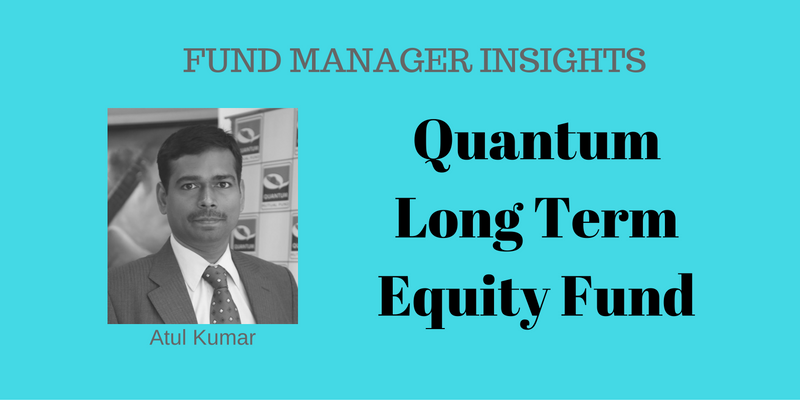Unovest recently did an interview with Atul Kumar, Fund Manager of Quantum Long Term Equity Fund.
Atul has more than a decade’s experience in equity research and fund management. His strong dedication and simple investment style has won accolades for Quantum Long Term Equity Fund. Atul is also the Fund Manager of Quantum Tax Saving Fund.
In this interview, Atul tells us all that is important about the fund.
Let’s begin.
Why does Quantum Long Term Equity Fund exist? What’s the purpose?
The objective of Quantum Mutual Fund is to help every investor invest in Indian equities with our solid research process and low cost approach. Quantum Long Term Equity Fund over the last 10 years have performed across market cycles and aim to generate sensible risk adjusted return over the long term.
We follow the value style of investing and the fund is driven by a disciplined approach to valuations. The scheme is not afraid to increase cash levels when markets are overvalued. The fund may appear to follow a conservative approach but we believe that over the long term it has delivered on the mandate.
What is the investment strategy of this scheme?
To invest in companies which have strong corporate governance, capable management teams and not too much debt leverage. And finally, the stock should be available at a reasonable valuation.
The scheme has Sensex Total Return Index (TRI) as its benchmark. However, your fund objective states “investing primarily in shares of companies that will typically be included in the BSE 200″.
How does an investor understand this?
Quantum Long Term Equity Fund (QLTEF) is a diversified equity scheme. QLTEF invests only in liquid stocks which have daily volume of USD 1 Mn (approx. Rs 6.5 Crores) on both stock exchanges. Such stocks are difficult to manipulate and the NAV is real. Currently, there are about 300 stocks meeting these criteria.
Since a large proportion of our holdings are large cap stocks, the BSE 30 TRI is the benchmark. The S&P BSE 30 TRI, which is the benchmark for QLTEF reflects the Gross Profits of the 30 stocks of S&P BSE Sensex, whereas S&P BSE Sensex keeps the Net Profit as its benchmark.
S&P BSE 30 Total Return Index (TRI) = Gross Profits
S&P BSE Sensex = S&P BSE 30 TRI – dividend payouts by companies
Obviously, the S&P BSE 30 TRI is a higher benchmark and therefore a tougher benchmark to beat.
That apart, we also have BSE 200 as additional benchmark. Investors are free to compare our performance against either of the benchmarks.
How do you pick the investments for this scheme? What are the evaluation parameters? What kind of sectors, stocks, etc. do you focus on?
We cover around 140 stocks. These are modeled in detail by our team and updated regularly. All the stocks have internally defined buy and sell limits. We only buy stocks that meet the buy criteria and sell them once they cross the sell limit.
We are sector agnostic. One sector in which we have not invested so far is the real estate sector, largely because financial numbers are opaque.
The scheme tends to hold cash at various times. What is the highest level of cash you can go upto? How do you put that into perspective for an investor?
The maximum cash level that can be held by the scheme is 35%. If we believe that the markets are overvalued and will correct at some point, it makes better sense to protect capital by selling overvalued stocks.
Historically, we have also witnessed that markets correct after our cash allocation goes up significantly and we then are ideally placed to invest in opportunities emerging out of a falling market. Most importantly, it helps to reduce risk.
What will you NOT do as part of managing this scheme?
The scheme follows a defined process.
It does not invest in companies where we are not comfortable or convinced about corporate governance.
Companies that have been unfair to minority shareholders are excluded.
It will also never invest in stocks which look overvalued to us no matter how exciting the company’s story may be.
As a fund manager, how do you see India (individually and along with the world) going forward? What kind of opportunities are there currently or likely to emerge specially from an investing point of view?
India is likely to grow Real GDP at 6 – 6.5% for many years in the foreseeable future. This is equivalent to nominal GDP growth of 13-13.5%. Accordingly, the equity returns can be in the range of 14-15% p.a. assuming many companies will be able to efficiently manage their expenses even with such high growth.
Retail investors have massive under-allocation to Indian equities. As this corrects, there will be plenty money from retail which will lift valuations and lead to a better return for existing equity investors.
—
Thank you Atul. You have shared some wonderful insights about the fund with us.
Disclaimer: The purpose of the interview is only to educate investors. This is not a fund recommendation.
